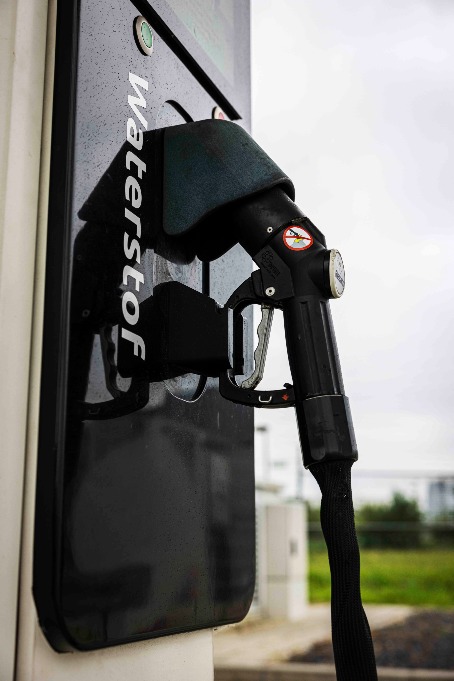Waterstof toepassen in de auto of op de WC
Hoogleraar Energieomzetting Aravind Purushothaman Vellayani werkt aan systemen die waterstof gebruiken om elektriciteit te produceren, bijvoorbeeld in grote fabrieken. Maar ook je auto of zelfs je toilet kunnen elektriciteit uit waterstof produceren. Aravind: ‘De technologie is er al, maar voor commerciële toepassingen is dat nog vaak te duur. Daar ligt dus een rol voor de wetenschap: om de stap van fundamentele kennis naar toepassingen te overbruggen.’
FSE Science Newsroom | Tekst Charlotte Vlek | Beeld Leoni von Ristok

‘Er is ontzettend veel onderzoek naar waterstof gaande bij de Rijksuniversiteit Groningen, en technologisch gezien is er al heel veel mogelijk.’ In zijn kersverse rol als Director Hydrogen Economy bij de Wubbo Ockels School for Energy and Climate wil professor Aravind al die mogelijkheden bij elkaar brengen, binnen en buiten de muren van de universiteit.
In zijn eigen onderzoek werkt Aravind dan ook veel samen met industriële partners. ‘Waterstof is uitstekend in te zetten in de transportsector, bijvoorbeeld voor binnenvaartschepen of vrachtwagens. Een brandstofcel op basis van waterstof heeft als voordeel dat het geheel weinig weegt, en dat je er langere afstanden mee kan afleggen dan bijvoorbeeld een elektrische auto.’
Van fundamentele vragen naar toepassing
We willen precies weten hoe de elektroden in zo’n systeem werken, of wat er met een brandstofcel gebeurt wanneer de invoer van waterstofgas varieert in samenstelling of temperatuur.
In het lab werken promovendi in de groep van Aravind aan fundamentele vragen, die beantwoord moeten worden om zulke grootschalige toepassingen goed te laten verlopen. Ze bestuderen de kleinste details van elektrolysers die elektriciteit in waterstof omzetten, brandstofcellen die waterstof in elektriciteit omzetten, of systemen die beide reacties kunnen uitvoeren: van elektriciteit naar waterstof en terug.
Het doel is natuurlijk om die energie-omzettingen zo efficiënt mogelijk te laten verlopen. Aravind: ‘We willen bijvoorbeeld precies weten hoe de elektroden in zo’n systeem werken, of wat er met een brandstofcel gebeurt wanneer de invoer van waterstofgas varieert in samenstelling of temperatuur. Wanneer ons lab volledig up en running is, hopen we dit heel precies te kunnen meten terwijl de echte omzetting plaatsvindt, wat vrij uniek zal zijn.’
Brede benadering
Aravind combineert het werk in het lab met computermodellen, die precies in kaart brengen waar de warmte zich in een systeem bevindt, en dus kunnen laten zien waar energieverliezen plaatsvinden. Zo werkt een promovendus bijvoorbeeld aan modellen van de HydroHub, een testcentrum op Zernike Campus waar verschillende typen elektrolysers op grotere schaal kunnen worden uitgetest. Aravind: ‘De efficiëntie kan bij het opschalen namelijk veranderen, dat zijn we dus aan het onderzoeken.’
Over auto's en WC's
‘Het leukste voorbeeld van een systeem dat energie kan omzetten, is uit mijn tijd bij de TU Delft,’ vertelt Aravind. ‘Toen werkten we aan een toilet dat waterstof uit menselijke uitwerpselen omzet in elektriciteit. Het idee was: in plaats van alle uitwerpselen afvoeren en met veel energie het rioolwater weer opschonen, kun je ze ook ter plekke gebruiken als bron van energie, bijvoorbeeld in een gemeenschappelijke toiletruimte die dubbelt als energiecentrale voor de buurt.’

In het onderzoek van Aravind kan bijna álles als energiecentrale dienen. Ook je waterstofauto van de toekomst, die je bij thuiskomst op je oprit parkeert: ‘Je sluit hem aan op een leidingnetwerk dat waterstof levert, en je hebt je eigen energiecentrale voor de deur. Kun je het je voorstellen? Dan hoef je voortaan niet meer te betalen om ergens te mogen parkeren, maar kun je er geld mee verdienen.’
Noord-Nederland is Hydrogen Valley Campus Europe : dé plek in Europa waar groene energie aan land komt (van windmolenparken op de Noordzee), waar jarenlange ervaring is met gas, en waar universiteiten en hogescholen en MBO’s de komende tijd gaan werken aan nieuw onderzoek én het opleiden van de volgende generatie technici voor de waterstofeconomie van de toekomst. Dit is aflevering 2 van een reeks over waterstof-onderzoek aan de Faculty of Science and Engineering van de Rijksuniversiteit Groningen.
Lees meer:
Waterstof is een indirect broeikasgas: door reacties met andere verbindingen in de atmosfeer kan het op meerdere manieren bijdragen aan de opwarming van de aarde.
Waterstof is een veel kleiner molecuul dan aardgas en zou dus gemakkelijker kunnen ontsnappen. Maar, erger nog: waterstof, hoe klein het ook is, kan grote materialen aantasten en ze zo breekbaar maken als glas.
De techniek om op een duurzame manier waterstof uit water te winnen bestaat al een eeuw, maar waterstof uit aardgas halen is goedkoper. Daarom werken wetenschappers van de RUG aan technieken om groene waterstof efficiënt, betaalbaar en schaalbaar te produceren.
De beloftes van groene waterstof zijn groot. Maar grijze waterstof uit aardgas is vooralsnog veel goedkoper, de opslag van waterstof is niet triviaal, en als indirect broeikasgas is waterstof niet zo schoon als het lijkt.
Meer nieuws
-
06 januari 2026
AI-phasie: kunstmatige intelligentie helpt bij taalgebrek
-
06 januari 2026
Beter zicht op de werkpaarden van ons lichaam
